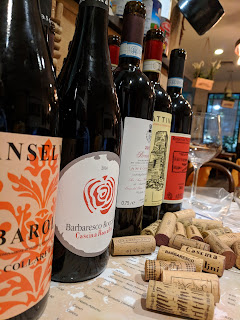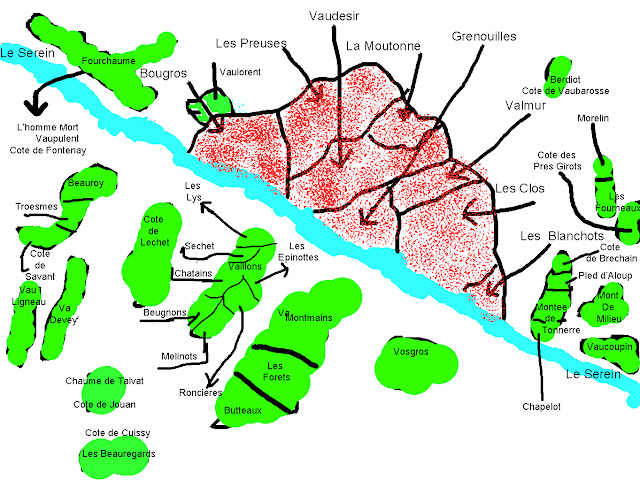Arpepe, Antoniotti, Franchino, Paolo Veglio, Anselma
Nebbiolo is definitely the king grape varieties of Italy.
From Northern Italy on the West part, mainly on the region of Piedimonte
and Lombardia.
Barolo and Barbaresco are the main Appellation or Denomination which made
him “Nebbiolo” famous around the world.
These two denominations are producing cellaring wines to be drunk after
a while of the state vintage, long ageing potential and definitely great
pleasure with food.
Nebbiolo takes his name from the foggy layer or dust on the skin of the
grape; a foggy resemblance.
This grape varieties before release needs time in barrel to give a softened
element to the tannin which are the main characteristic of this variety.
Long ageing process result a elements of oxidative notes through nose and
palate: dry rose petal, violet, licorice and sour red fruit… element of
minerality as tar, dusty rocks and leather which come from the calcareous stony
bed rock soil of this area. With ageing, more tertiary character will develop the complexity of the wine.
In the northern part of Piedimonte there is an area called ALTO PIEMONTE
with more heroic viticulture with psophourous, lime and clay soil. The Nebbiolo
locally called Spanna is made here, it is still having a great ageing
potential, however the different soil and this more austere climate definitely
100% continental, will give to the wines fresh crispy tension acidity but with finer
elegant tannin with the core of minerality you expect on the brother Barolo and
Barbaresco.
In Lombardia region in the north part there is another denomination
called Valtellina, that perfectly capture the pure essence of Nebbiolo and here the vines
are all built on terrace perimeter by ancient stone wall. Soil is calcareous
and full active limestone, Nebbiolo locally called Chiavennasca is bright
cherry, mineral and silky present tannin.
In Melbourne last week we organise a dinner showing 5 different producer in different denominations around this beautiful grape.
The First wine was
Arpepe Rosso Valtellina DOC 2015
The Perego family have been tending vines on these sheer granite terraces in the mountainous Valtellina since 1860. The vines are so far north into the alps they are practically in Switzerland.
They work only with Nebbiolo, or Chiavennasca as it is called in these parts, growing the grapes up to 700 metres above sea level on sheer, south-facing, sunlit vines that dig straight into rock. The resulting fruit is intensely mineral.
Production is very much of the old-school and labour is intense. The hills, making it very difficult to reach the fruit at all. Everything in the vineyard is done by hand and in the cantina "Winery" the family exercises a soft touch with great patience, leaving the wines to rest until they are deemed ready for release.
The transparency of the grape, the singular landscape and the Peregos' gentle hand in the winery lend these wines a remarkable sense of place.
The wine was bright ruby and translucent, youthful with fresh cherry nose along beautiful floral notes as violet and rose petal. Classic minerality with smooth tannin almost a Pinot noir phenolic silkiness.
The alcohol was medium and very pleasant. Great introduction of the Chiavennasca in this DOC... Vlatellina has their single site called Inferno, Maroggia, Valgella, Sassella and Grumello and with more ageing process make pretty cellaring wine.
Ps.
In the Swiss part the name can appear as “Stagafassli”.
Brioche con Porchetta,
Vitello Tonnato, Crostini di Polenta,
Peperoni e Bagna Cauda.
The next dish was done with the two following wines:
Gattinara
Gattinara is a red Italian wine (DOCG) Denominazione
di Origine Controllata e Garantita, produced from Nebbiolo grapes grown within
the boundaries of the commune of Gattinara. Located in the hills in the north
of the province of Vercelli, northwest of Novara in the Piemonte region. It was
awarded DOC status in 1967 and received its DOCG classification in 1990.
The wine is made primarily from the Nebbiolo grape
variety (known locally as Spanna) which must constitute a minimum 90% of the
wine and may be blended with up to 10% Bonarda and no more than 4% of
Vespolina.
The ageing requirement is 35 months with minimum 18
months in barrels. For the Riserva is 47 months with minimum 36 months in
barrels. The soil is rich on calcareous (high active ironstone and phosphorous).
Mauro Franchino is one of the oldest producer in
Gattinara, he has harvested more than 50 vintages and he has only 3 hectares of
vines.
The wine 100% Nebbiolo is fermented in concrete vats
and aged in Botti for 3 years. Only 3000 bottles are made each year.
Gattinara Mauro Franchino 2012
The wine show pretty red fruit as wild cherry and raspberry with a tart element along notes of leather fresh crispy acidity and long ageing with great finesse... Elegance as a burgundy "Morey St. Denis" complexity as a great Brunello but it is a great Nebbiolo form one of the most beautiful Denomination in the Alto Piemonte.
The wine show pretty red fruit as wild cherry and raspberry with a tart element along notes of leather fresh crispy acidity and long ageing with great finesse... Elegance as a burgundy "Morey St. Denis" complexity as a great Brunello but it is a great Nebbiolo form one of the most beautiful Denomination in the Alto Piemonte.
Bramaterra
Bramaterra is another D.O. Denomination of Origin from
the neighborhood of the Gattinara DOCG, sharing the same soil rich in iron,
potassium and manganese.
Result high in Mineral content in the wine.
Here as well the Nebbiolo is called Spanna and is
blended with an endemic grapes variety in the area called Croatina, Vespolina
and Bonarda.
By the legislation the Nebbiolo need to be minimum 50%
to maximum 80%.
Antoniotti is another old producer in this area; his
Bramaterra is 70% Nebbiolo, 20% Croatina, 7% Vespolina, and 3% Bonarda.
The wine is aged in Large botti 1250L for 30 months.
By Law the requirement of ageing is 22 months with 18
months minimum in barrels.
Riserva is 34 months with 24 months in barrels.
Antoniotti Bramaterra 2012
The Antoniotti was more austere, very close nose with the minerality as a core of the wine. Slighty dusty but stony and granitic, very masculine tannin with energy and droit acidity.
Antoniotti Bramaterra 2012
The Antoniotti was more austere, very close nose with the minerality as a core of the wine. Slighty dusty but stony and granitic, very masculine tannin with energy and droit acidity.
Paglia e Fieno al sugo di
lepre.
The Main course was with two wines a Barolo and a Barbaresco:
Barolo
Barolo
is a (DOCG) Denominazione di Origine Controllata e Garantita, produced in the
northern Italian region of Piemonte. It is made from the Nebbiolo grape. The zone of
production extends into the communes of Barolo, Castiglione Falletto, Serralunga
d'Alba and parts of the communes of Cherasco, Diano d'Alba, Grinzane Cavour, La
Morra, Monforte d'Alba, Novello, Roddi, Verduno, all in the province of Cuneo,
south-west of Alba. Clones authorized are Lampia, Michet and Rosae.
The Barolo is a single
vineyard called Collaretto in the Commune of Serralunga d’Alba, on white soil
full of Limestone called “Serravallian” from Miocene era alternating layers of
beds of sand and sandstone layered with marls and sandy marl. The wine tonight
ageing only in Big Slavonian Oak Tree Botti.
Barolo before release spend 34
months in the cellar with 18 months in barrels.
The Riserva 58 months with 18
months in barrels.
Botti is a traditional producer,
Barrique is a modern producer.
Anselma "Collaretto" Barolo Serralungha D'Alba 2010
2010 a lovely vintage the wine is a super traditional producer, long maceration on primary fermentation and ageing for over 2 years in big Italian botti. Collaretto is a Cru in the Serralungha commune just next to the prices and fancy "Great" Vigna Rionda vineyard. Masculine Barolo with cherry liquer, rose, violet and liquorice... Great oxidative hint with a lovely volatile acidity which give freshness and musk the 15% Alcool... A must..
2010 a lovely vintage the wine is a super traditional producer, long maceration on primary fermentation and ageing for over 2 years in big Italian botti. Collaretto is a Cru in the Serralungha commune just next to the prices and fancy "Great" Vigna Rionda vineyard. Masculine Barolo with cherry liquer, rose, violet and liquorice... Great oxidative hint with a lovely volatile acidity which give freshness and musk the 15% Alcool... A must..
Barbaresco
Is the cousin of Barolo made
in the Comune of Barbaresco, Treiso, Neive.
Very similar soil but the
ageing profile is a bit shorter with a final result a silk wine, in some way more feminine style. However sometimes some Barbaresco can be more powerful than a
Barolo. All is coming from the vineyard size and the producer.
As well as in Barolo here there
are the Traditional producer ageing only in big Botti
and the modern boys ageing in
French Barrique. Some does a mix of the 2 types.
By law the Barbaresco ageing is
22 months with 9 months in oak.
Riserva 46 months with 9
months in oak.
The wine tonight is from a
single vineyard and a traditional style producer.
Cascina Roccalini Barbaresco 2014
Cascina Roccalini Barbaresco 2014
From the Roccalini Vineyard in the commune of Barbaresco; made by Paolo Veglio in his Propriety called Cascina Roccalini.
Tannin were stronger of the Barolo but the nose more floral. The structure was very complex with a long finish. The wine was support by the tension of the acidity with a tight spine energy.
Brasato
di Manzo al Barolo con Purea al Tartufo
The restaurant Michelangelo in the CBD in Melbourne run by Matteo and Ilaria
Thanks for their hospitality and amazing food ..
michelangelosteria.com.au/
--
--
Best
Raf
Drinking and listening sculpture sound: Abruzzo & Melbourne
--------------------------------------
wine / spirit / lambic / drinker













Comments
Post a Comment